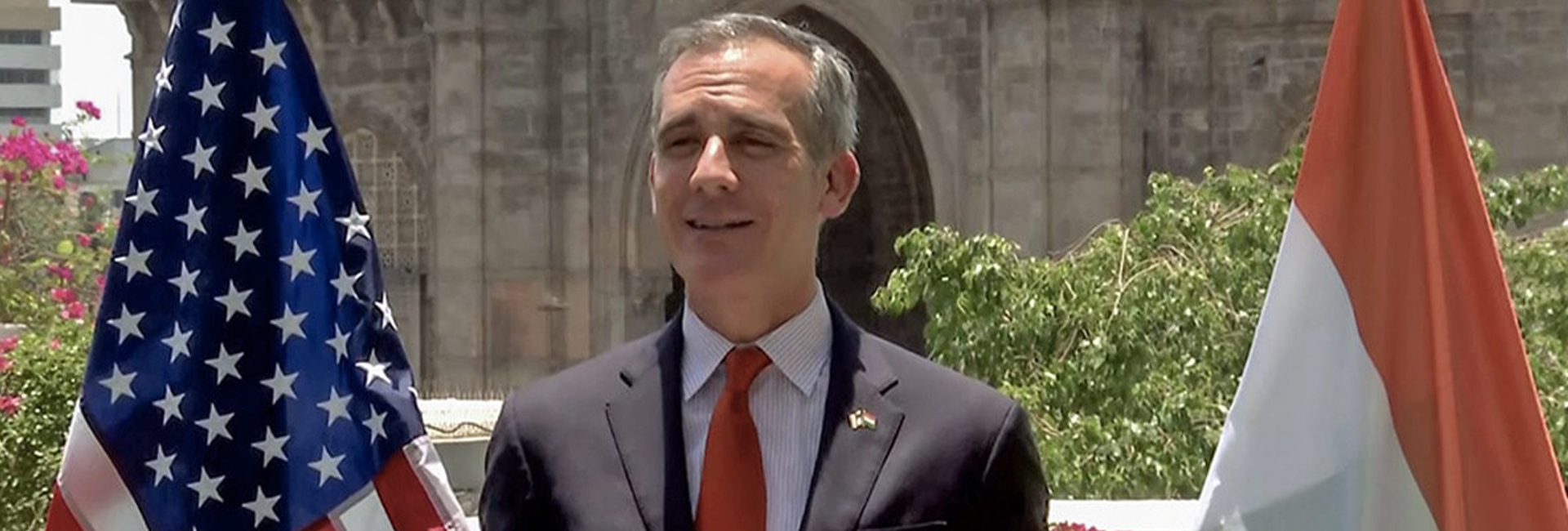(May 23, 2023) Eric Garcetti’s Indian love story began when he was a teenager. He recalls that trip vividly, down to the name of the tea stall in Old Delhi, ‘Aap ki Pasand’, which he visited twice. And most of all, he remembers the warmth he received from the Indian people. “I came to India for the first time when I was a teenager. And even though the place has changed so much, the warmth and friendliness of everybody remains the same,’ he said, speaking at event shortly after he took charge as the US Ambassador. As it happens, the ties run even deeper than that – remarkably enough, Garcetti came back when he was 19, to stay with the then-US Ambassador, because his son was his college roommate. “The universe works in mysterious ways,” Garcetti remarked. In fact, back in 2013, Garcetti, who was a mayoral contender then, attended a breakfast meeting of entrepreneurs and addressed a Sikh businessman in Hindi.
Even so, maybe there was a fault in the stars, but Garcetti’s passage to India as the Ambassador was not an easy one. He was nominated back in 2021 by US President Joe Biden, as he served the last few years of his tenure as Los Angeles mayor. That final leg was steeped in controversy – the Senate stalled his appointment. The key post been left vacant for well over two years, after Kenneth Juster’s term ended on January 20, 2020. It was the longest time without a US envoy to India. Finally, in 2023, Garcetti was sworn in by US Vice President Kamala Harris.

US Ambassador Eric Garcetti with Reliance Industries Chairman, Mukesh Ambani
Garcetti is here at a crucial time, as India and the US recently launched the Critical and Emerging Technology initiative to focus on the development and production of military hardware equipment and expanded cooperation in the Indo-Pacific region. And despite differences over the response to Russia’s invasion of Ukraine, the Joe Biden cabinet hopes India will balance the rise of China. He has been well-received, spotted posing with the likes of Shah Rukh Khan and Reliance Chairman Mukesh Ambani, trying his hand at a game of cricket and eating vada pav.
Garcetti’s legacy as mayor
They have found the right man for the job. Garcetti is no stranger to challenges – he entered the mayor’s office as the youngest mayor in LA for over a century. He came prepared for the unexpected and his expectations were surpassed. “I have told my successors and other contendors, there are two jobs to being mayor. One, there are the things, you want to see, your proactive agenda. Second are the things you hope will never happen but you know will, like an earthquake, civil unrest, or in my case, a pandemic,” he said in an interview, looking back at his thorny decade as mayor.
The homelessness crisis skyrocketed, going up by over 30 percent during his tenure, which he described as the ‘result of four decades of failure’. He also guided the city through the pandemic, soothed civil unrest during the ‘defund the police’ campaign, and oversaw the passage of ‘Measure M’ to make public transport more affordable. He also brought about the Twenty-eight by 28 initiative, an effort to complete 28 transport infrastructure projects before the 2028 Summer Olympics to be held in L.A.
Early life
Eric Garcetti was born on February 4, 1971 in Los Angeles. He grew up in Encino in the San Fernando Valley, the son of Sukey and Gil Garcetti, who is the former LA County DA. His paternal grandfather was born in Chihuahua, the son of an Italian immigrant who married a Mexican woman. He was hanged during the Mexican Revolution and his son, Salvador came to the United States. His maternal grandparents were Russian-Jewish immigrants – both sides of the family put down roots in Boyle Heights, where Garcetti grew up.
“I have an Italian last name, and I’m half Mexican and half Jewish,” Garcetti remarked during his first run for the Mayor’s office in 2013, after having served as Councilman for nearly a decade. He donned a yarmulke and sang Hanukkah songs with rabbis, and stood on the steps of City Hall wearing a Peruvian headpiece and speaking Spanish to show his support for the stretch of Hollywood’s Vine Street that was renamed Peru Village’. It went a long way with LA’s multicultural fabric. He became the city’s first Jewish mayor and the second Mexican American.
The young Garcetti was an excellent student and politically savvy, too. In high school, he was a member of the Junior State of America, which promoted civic engagement and political debate among students. He majored in political science and urban planning from Columbia University, which he attended as John Jay Scholar. Even there, he was on the student council, president of the St Anthony Hall fraternity and founded the Columbia Urban Experience.
After graduating, Garcetti was selected as a Rhodes Scholar and studied at Oxford and the London School of Economics. He did his research and human rights missions in East Africa and was a visiting instructor of International Affairs at the University of Southern California, and an assistant professor of Diplomacy and World Affairs at Occidental College. He served as a lieutenant in the United States Navy Reserve Information Dominance Corps from 2005 to 2013.

Garcetti served as a Lieutenant in the US Navy Reserve for eight years. Photo: LA Times
Public life
In 2001, Garcetti was elected to City Council District 13. In 2006, he was elected as Council President and remained in the post for six years. He implemented the Constituent Bill of Rights, ensuring that phone calls from constituents were returned in a day, and also held “office hours”, meeting with them face to face. In 2004, Garcetti composed Proposition O to clean the city’s waterways and helped the city cut its water use to deal with drought.
Eric Garcetti declared his mayoral candidacy in 2011 and was elected two years later. In 2017, he won by a landslide, serving for five years and six months, much longer than the standard term of four years. He worked towards LA leaving behind its personal car culture in favour of walkability and public transport, a big step in the city’s urban plan.
In the arts
He’s an accomplished pianist, given to “soul, jazz and Keith Jarrett-esque improvisations,” as he puts it. In college, he performed in the student-written musical tradition the Varsity Show, for three years. “My great grandparents played the piano, my grandparents met at music school and my mom played as well,” he said. “I was continuing the family tradition.” He even kept a piano in the mayor’s office, playing for a few minutes between meetings or whenever he got the chance, to “clear his head.”
Eric Garcetti married his longtime girlfriend Amy Elaine Wakeland, a fellow Rhodes scholar, whom he met a Oxford. They adopted their daughter, Maya Juanita, and have also fostered seven children.
Follow Eric Garcetti on Instagram and Twitter.
Discover more fascinating Stories



